We’ve found that properly sizing your water softener can prevent costly replacements and salt waste. Calculate your needs by multiplying: (number of people × daily water use per person × water hardness in GPG). For a family of four with 10 GPG hardness, choose a 32K-40K grain system with weekly regeneration. Factor in peak flow rates (8-12 GPM) and add capacity if you have iron. The right calculations now will save thousands over your system’s lifespan.
Key Takeaways
- Select a 32,000-grain system for 1-2 people with 5-10 GPG hardness; 48,000 grains for larger households with 11-20 GPG.
- Calculate your daily requirement using: Number of people × Daily water use × Water hardness (GPG) × 1.5 safety factor.
- Consider flow rate requirements of 8-12 GPM for average homes to prevent pressure drops during peak usage.
- Add 25-50% capacity when iron exceeds 1 PPM, as each PPM of iron adds approximately 5 grains of hardness.
- Proper sizing prevents premature system failure, maintains water pressure, and avoids frequent costly regeneration cycles.
Understanding Water Hardness Tests and Measurement Units
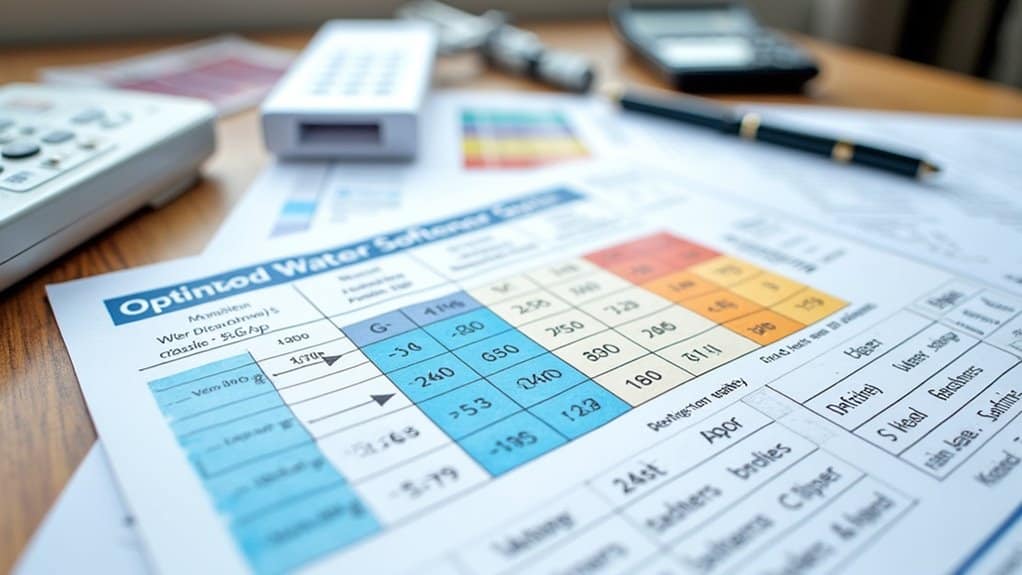
Before selecting an appropriately sized water softener, we must understand how water hardness is measured and expressed.
Water hardness can be quantified through several methods, with titration using EDTA being the most precise laboratory technique. For home testing, test strips provide adequate ranges from 0-425 ppm. Digital titrators offer higher precision measurement than standard drop count kits for those seeking more accurate readings. Understanding these testing methods is crucial for homeowners.
Hardness is commonly expressed in grains per gallon (gpg), parts per million (ppm), or milligrams per liter (mg/L). The industry standard is ppm as CaCO₃, though gpg is frequently used in residential applications (1 gpg = 17.1 ppm). Knowing the conversion rates can help in choosing the right system.
Water below 3.5 gpg is considered soft, while anything above 7 gpg is hard.
How to Calculate Your Home’s Daily Water Softening Needs
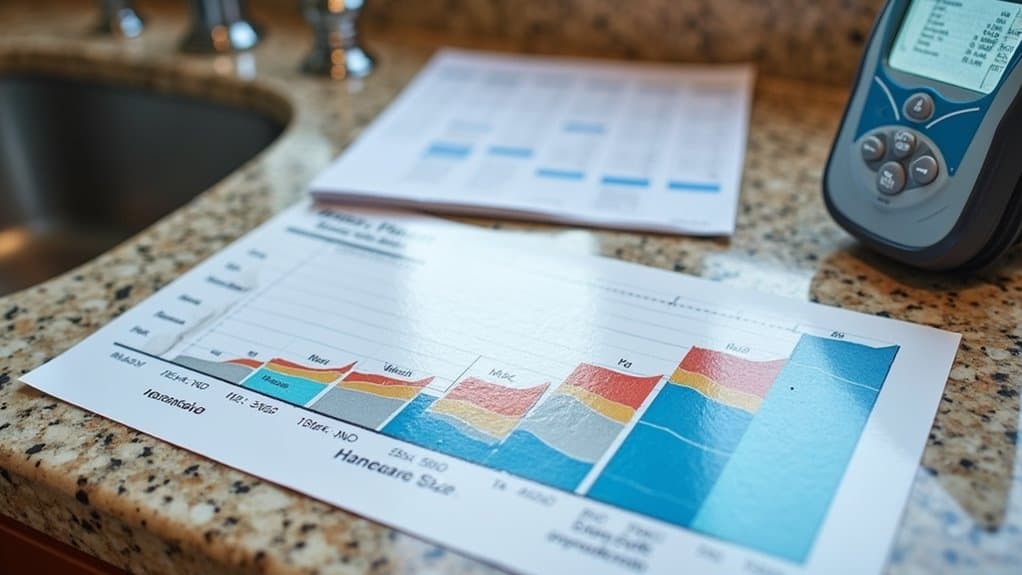
To accurately size your water softener, you’ll need to calculate your home’s daily softening requirements based on three critical factors: household size, daily water consumption, and water hardness level.
The core formula we use is: Daily Softening Requirement = Number of people × Daily water use per person × Water hardness (GPG).
- For a family of 4 with 75 gallons/day usage at 10 GPG, daily requirement equals 3,000 grains.
- Multiply by 7 for weekly regeneration cycles (21,000 grains capacity).
- Apply a 1.5 safety factor to account for usage fluctuations. Understanding water softening requirements is essential for selecting the right system.
National water usage averages range from 50-82 gallons per person daily.
Water hardness ≥7 GPG requires treatment; ≥10 GPG is considered “very hard.”
Professional water testing can detect exact hardness levels and help prevent selecting an inappropriate water softener size.
Selecting the Right Grain Capacity for Your Household Size
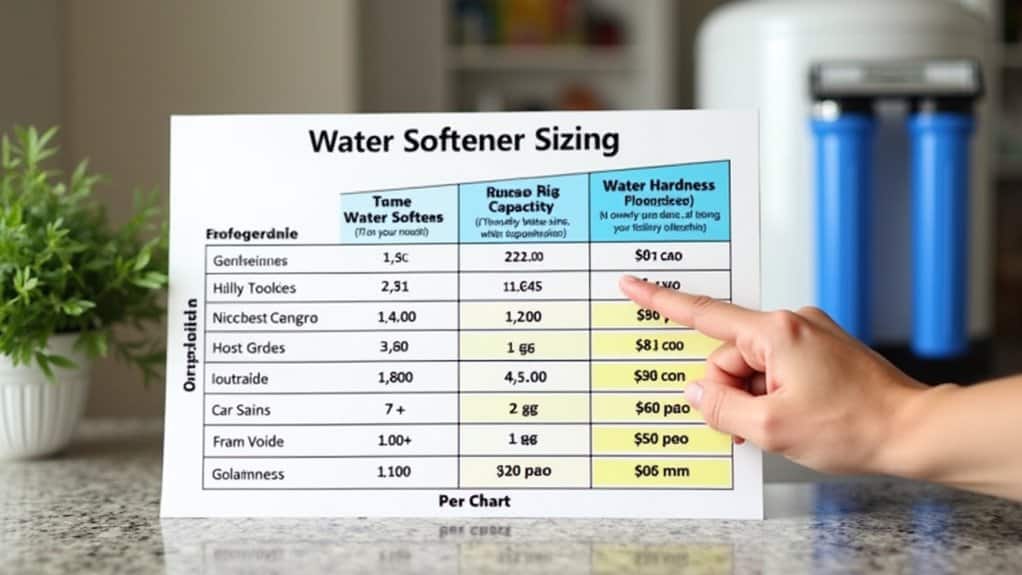
Choosing the right grain capacity for your water softener represents the most critical decision in your purchasing process.
We’ve developed household-based recommendations that account for both water hardness and occupancy. Household size plays a significant role in determining the appropriate water softener capacity.
For 1-2 residents with moderately hard water (5-10 GPG), a 32,000-grain system suffices.
Larger households of 5-6 people should select 40,000-grain systems for the same water conditions, increasing to 48,000 grains for harder water (11-20 GPG).
Remember to adjust capacity upward by 25-50% when iron content exceeds 1 ppm, as each ppm adds 5 grains of perceived hardness to your calculations.
Selecting a system that’s too small for your needs will result in premature failure of your water softener and unsatisfactory water quality throughout your home.
Flow Rate Requirements and System Performance Factors
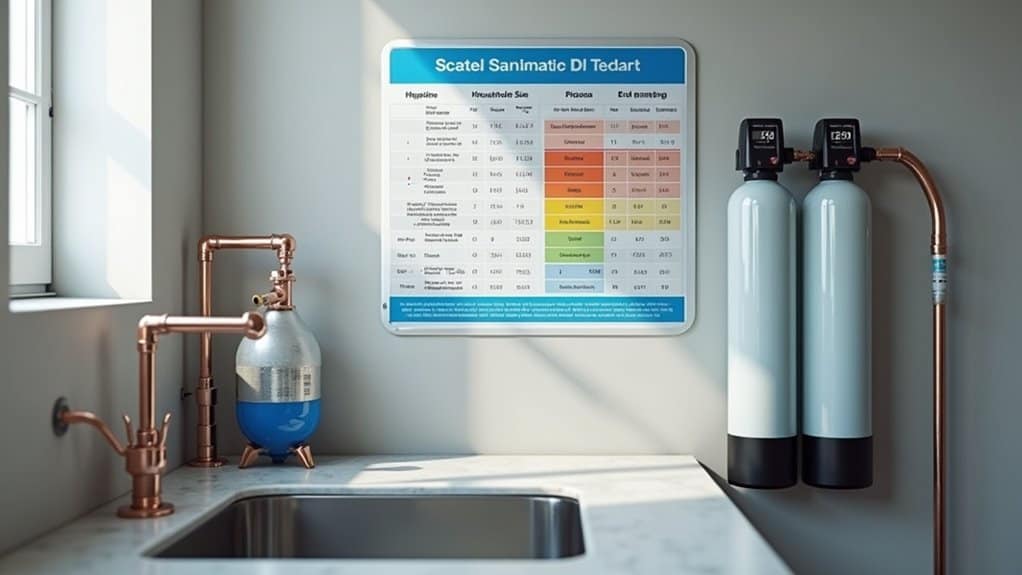
When selecting a water softener, flow rate capability becomes equally critical as grain capacity for ensuring optimal performance throughout your home.
We’ve found that insufficient flow rates lead to pressure drops during peak usage periods, compromising your system’s effectiveness. Effortless water softener sizing can help in determining the right balance between flow rate and grain capacity.
Key flow rate considerations include:
- Calculate peak demand by summing concurrent fixture usage (typically 8-12 gpm for average homes)
- Verify component integration—bypass valves, control valves, and tank dimensions must align
- Consider resin bed dynamics—deeper beds increase efficiency but may reduce flow
- Evaluate twin-tank systems for high-usage households requiring continuous soft water
- Remember salt-based systems handle extreme hardness better than salt-free alternatives
Undersized water softeners can create significant water pressure problems and result in untreated hard water passing through your system during periods of maximum simultaneous water use.
Frequently Asked Questions
How Long Do Water Softener Resin Beads Typically Last Before Replacement?
Water softener resin typically lasts 10-15 years with standard 8% cross-linked resin, while high-cross-linked variants (10%+) can extend to 20+ years. Chlorine exposure reduces longevity to 5-7 years.
Can Water Softeners Remove Lead or Other Heavy Metals?
Water softeners don’t remove dissolved lead or heavy metals. While some may trap particulate lead in specialized resin, you’ll need NSF-certified lead filters or reverse osmosis systems for effective heavy metal removal.
Do Water Softeners Increase Home Water Pressure?
No, water softeners don’t increase water pressure. In fact, they can slightly reduce it due to flow restrictions through resin beds. We recommend proper sizing to minimize pressure drops.
Are There Salt-Free Alternatives That Actually Work?
Yes, salt-free alternatives (TAC systems, magnetic conditioners) successfully prevent scale in pipes. We’ve found they’re effective for mild-to-moderate hardness but don’t truly soften water like ionic exchange systems do.
How Much Electricity Does a Water Softener Use Monthly?
Water softeners consume minimal electricity, averaging about 5.8 kWh monthly—equivalent to running an alarm clock. We’ve found they draw continuous low power during standby and slightly more during regeneration cycles.
Conclusion
We’ve examined the critical factors for optimal water softener sizing: accurate hardness testing, precise daily softening requirements calculation, appropriate grain capacity selection, and flow rate analysis. By matching these technical specifications to your household’s specific consumption patterns and water chemistry, you’ll avoid both undersized systems that regenerate excessively and oversized units that waste resources. This methodical approach ensures maximum efficiency, extending system longevity while minimizing salt, water, and maintenance costs.

Craig “The Water Guy” Phillips is the founder of Quality Water Treatment (QWT) and creator of SoftPro Water Systems.
With over 30 years of experience, Craig has transformed the water treatment industry through his commitment to honest solutions, innovative technology, and customer education.
Known for rejecting high-pressure sales tactics in favor of a consultative approach, Craig leads a family-owned business that serves thousands of households nationwide.
Craig continues to drive innovation in water treatment while maintaining his mission of “transforming water for the betterment of humanity” through transparent pricing, comprehensive customer support, and genuine expertise.
When not developing new water treatment solutions, Craig creates educational content to help homeowners make informed decisions about their water quality.


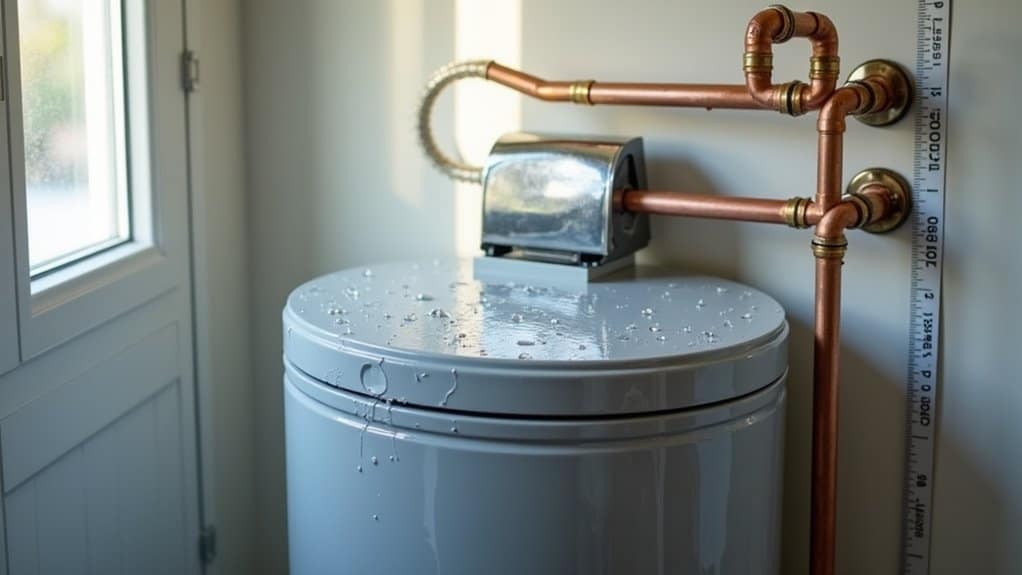
This is really interesting, You are a very skilled blogger. I have joined your feed and look forward to seeking more of your magnificent post. Also, I have shared your web site in my social networks!